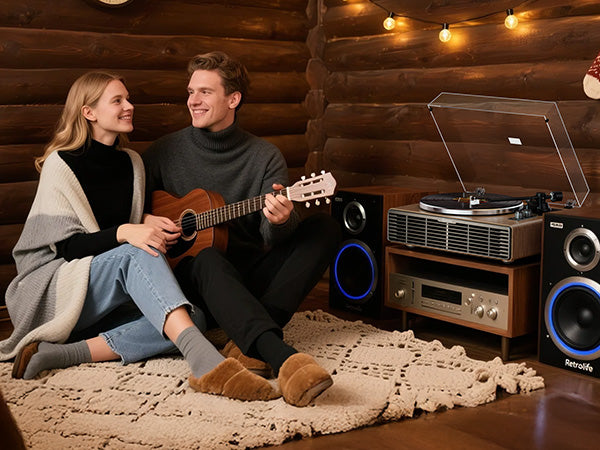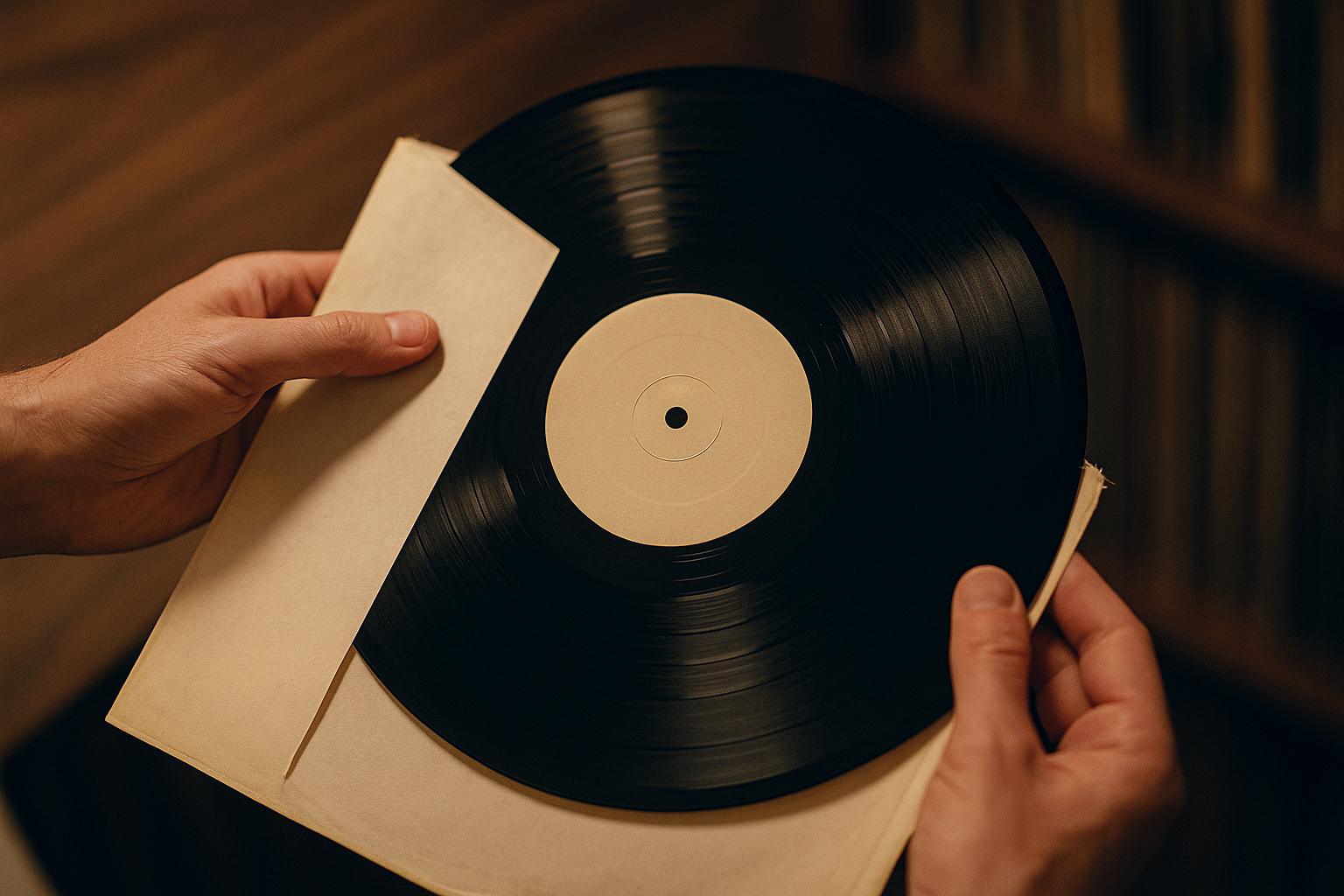The resurgence of vinyl isn't just about nostalgia; it's a conscious choice for a tangible, arguably more intentional, listening experience. But the magic of a spinning record can only be fully unlocked with the right companions. Choosing the "best" speakers for your record player is a journey fraught with audiophile jargon, marketing superlatives, and deeply personal preferences. This guide aims to cut through the noise, exploring the first principles of sound reproduction, the realities of system synergy, and the often-overlooked human elements that define your ideal sonic outcome.
1. Deconstructing "Best": The Illusory Pursuit of a Universal Ideal
The very notion of "best" in audio is a seductive trap. What does it truly mean?
-
First Principles of Sound Reproduction: At its core, a speaker's job is to convert an electrical audio signal from your amplifier into mechanical vibrations (sound waves) as accurately as possible, without adding or subtracting from the original signal. This is the ideal of "high fidelity." However, "accuracy" itself can be debated. Is it a ruler-flat frequency response, or something that sounds subjectively "right" or "musical"?
-
Human Nature & Subjectivity: We don't listen with measurement microphones; we listen with our ears and brains, shaped by years of auditory experiences, musical tastes, and even psychological biases. What one person perceives as "detailed and analytical," another might find "harsh and fatiguing." The "warmth" cherished by some vinyl enthusiasts might be heard as "muddiness" by others. Your listening habits (volume levels, genres) and the acoustic properties of your room will profoundly influence your perception.
-
The Reality of Compromise: Every speaker design is a series of compromises – between size, cost, driver technology, and sonic characteristics. The "perfect" speaker that excels in every conceivable metric for every listener in every room simply doesn't exist, especially when budgets are a real-world constraint. The law of diminishing returns is also starkly evident in audio: each incremental improvement in perceived quality often comes at an exponentially higher cost.
-
Blind Spot – The Tyranny of "What's New" and Marketing Narratives: The audio industry, like any other, thrives on new models and compelling stories. It's crucial to distinguish genuine technological advancements from cleverly marketed iterations. The "best" speaker isn't necessarily the newest or the most expensive; it's the one that best serves your specific needs and integrates optimally with your system and environment.
2. The Chain of Command: Why Speakers Are Only Part of the Equation
A common pitfall is to obsess over speakers while neglecting the components that feed them. Your audio system is an interconnected chain; the final sound is only as good as its weakest link.
-
First Principle – System Synergy: Speakers don't operate in a vacuum. Their performance is intrinsically linked to the amplifier (or receiver) that powers them and, crucially for vinyl, the phono preamplifier.
-
Amplifier Matching: Power output (watts per channel), impedance compatibility, and the amplifier's own sonic signature will significantly impact how speakers sound. An underpowered amplifier can make speakers sound lifeless or strained, while a poor impedance match can lead to distortion or even damage.
-
The Phono Preamplifier: The signal from a turntable's cartridge is incredibly faint and requires two stages of processing: RIAA equalization (to correct the frequency imbalance inherent in record cutting) and amplification to bring it to "line level" (the standard strength for other audio components). The quality of the phono preamp (whether it's built into your turntable, amplifier, or is a standalone unit) has a profound impact on clarity, noise floor, and overall fidelity.
-
-
Reality – The Source Matters Most (Usually): While speakers are the voice of your system, the quality of the signal they are fed is paramount. A mediocre turntable or a noisy phono stage will be ruthlessly exposed by transparent, high-quality speakers. Conversely, even the "best" speakers cannot invent detail or musicality that isn't present in the source signal.
-
Blind Spot – The "Upstream" Bottleneck: Investing heavily in speakers without ensuring your turntable, cartridge, and phono preamp are of a commensurate quality is a recipe for disappointment. It's often more beneficial to have a balanced system than one with a single superstar component and several underperformers.
3. Decoding Speaker Specifications: Beyond the Numbers Game
Speaker specifications can be bewildering. Understanding what they actually mean in the context of vinyl playback is key.
-
Frequency Response (e.g., 50Hz - 20kHz ±3dB):
-
What it is: The range of frequencies a speaker can reproduce and how evenly it does so.
-
First Principle: A wider and flatter response generally suggests more accurate reproduction.
-
Vinyl Reality: Vinyl's inherent characteristics include potential low-frequency rumble (from the turntable motor or pressing imperfections) and a slightly different high-frequency presentation compared to digital. While you want speakers that can reproduce deep bass and airy highs, an exaggerated response in these areas can accentuate vinyl's flaws. The smoothness of the response is often more important than sheer extension.
-
Blind Spot: Quoted numbers don't tell the whole story. How a speaker measures in an anechoic chamber (a reflection-free room) can be very different from how it performs in your living room. Two speakers with identical on-paper frequency response can sound vastly different due to driver materials, crossover design, and cabinet construction.
-
-
Sensitivity (e.g., 88dB @ 1W/1m):
-
What it is: How loud a speaker will play with a given amount of amplifier power (typically 1 watt, measured at 1 meter). Higher numbers mean more efficient.
-
First Principle: More sensitive speakers require less amplifier power to reach a given volume.
-
Vinyl Reality: This is crucial for amplifier pairing. If you have a low-powered amplifier (common with some vintage gear or budget integrated amps), higher sensitivity speakers (e.g., 90dB+) are generally a better match. Using low-sensitivity speakers with a low-powered amp can lead to clipping (distortion) at moderate volumes.
-
Blind Spot: Sensitivity doesn't equate to sound quality. Some excellent-sounding speakers are relatively inefficient and demand robust amplification.
-
-
Impedance (e.g., 8 Ohms nominal, 4 Ohms minimum):
-
What it is: The electrical resistance the speaker presents to the amplifier. It's not a fixed value; it varies with frequency.
-
First Principle: Amplifiers are designed to work optimally with speakers within a certain impedance range.
-
Vinyl Reality: A speaker with a low minimum impedance (e.g., dipping below 4 ohms) can be a difficult load for some amplifiers, potentially causing them to overheat or sound strained. Most amplifiers are comfortable with 8-ohm nominal speakers. If considering 4-ohm speakers, ensure your amplifier is rated to handle them.
-
Blind Spot: "Nominal" impedance is an average. The minimum impedance and the phase angle (another electrical characteristic) are more telling of how difficult a speaker is to drive.
-
-
Driver Types & Enclosure Design:
-
Drivers: Woofers (bass), midranges, tweeters (treble) – their materials (paper, polypropylene, silk, metal) and design influence their sonic character.
-
Enclosures:
-
Sealed (Acoustic Suspension): Generally offer tighter, more articulate bass, but may not go as deep and can be less efficient.
-
Ported (Bass Reflex): Use a port or vent to augment bass output, often resulting in deeper bass and higher efficiency, but can sometimes sound "boomy" or less controlled if not well-designed.
-
-
First Principle: The physical design dictates how air is moved to create sound, impacting everything from bass extension to transient response (the ability to react quickly to changes in the music).
-
Vinyl Reality: The dynamic, sometimes uncompressed, nature of vinyl recordings can benefit from speakers with good transient response and controlled bass. The choice between sealed and ported depends on room size, musical preference (e.g., electronic music vs. acoustic jazz), and desired bass character.
-
Blind Spot: Exotic driver materials or complex enclosure designs don't automatically guarantee superior sound. Implementation and system synergy are paramount.
-
4. Passive vs. Powered Speakers: A Question of Integration and Intent
This is a fundamental fork in the road for many turntable setups.
-
Passive Speakers:
-
How they work: Require an external amplifier to power them. The signal path is typically Turntable -> Phono Preamp -> Amplifier -> Passive Speakers.
-
Pros:
-
Flexibility: Ability to choose and upgrade your amplifier independently.
-
Potentially Higher Ceiling: The option to pair with high-end amplification can lead to exceptional sound quality.
-
System Building: Allows for a more modular approach, swapping components as your tastes or budget evolve.
-
-
Cons:
-
More Components: Requires a separate amplifier (and often a phono preamp, unless integrated into the amp or turntable).
-
More Complexity: More cables, more setup considerations.
-
Potentially Higher Cost: The sum of individual high-quality components can be greater.
-
-
First Principle: Separation of duties – each component is optimized for its specific task.
-
-
Powered (Active) Speakers:
-
How they work: Have amplifiers built directly into the speaker enclosure. Many also include a built-in phono preamp, allowing direct connection from a turntable.
-
Pros:
-
Simplicity & Convenience: Fewer boxes, fewer cables, easier setup.
-
Optimized Matching: Amplifiers are often specifically designed and tuned for the drivers within that speaker, potentially leading to better synergy than haphazard passive pairings.
-
Space-Saving: Ideal for smaller rooms or minimalist setups.
-
Often Cost-Effective: Can offer good performance for the price as a complete system.
-
-
Cons:
-
Less Flexibility: You're locked into the built-in amplification. Upgrading means replacing the entire speaker unit.
-
Potential Quality Ceiling: While excellent powered speakers exist, the very highest echelons of audiophile sound are often still dominated by passive systems with dedicated, high-end amplification.
-
Repairability: If an amplifier component fails in a powered speaker, repair can be more complex or costly than with a separate amplifier.
-
-
First Principle: Integration for efficiency and potentially optimized internal synergy.
-
-
Reality Check: Neither is inherently "better."
-
Choose Passive if: You enjoy tinkering with components, already own a good amplifier, plan a long-term upgrade path, or are aiming for the highest possible fidelity without compromise.
-
Choose Powered if: You prioritize simplicity, have limited space, want a plug-and-play solution, or are building a system on a tighter budget where an all-in-one solution offers better value.
-
-
Blind Spot – The "Audiophile Snobbery" Factor: There's sometimes an unwarranted disdain for powered speakers in purist circles. However, modern powered speakers, especially those with well-implemented DSP (Digital Signal Processing), can offer outstanding performance and convenience that makes them a highly rational choice for many vinyl lovers.
5. The "Vinyl Sound" Myth: Do Your Speakers Need a Vintage Filter?
Many associate vinyl with a "warm," "rich," or "smooth" sound. Does this mean you need speakers that are inherently "warm" or "vintage-sounding"?
-
Human Nature & Nostalgia: The "vinyl sound" is partly a product of the recordings themselves (mastering techniques of the era), the pleasant coloration of some vintage equipment, and a healthy dose of nostalgia. Our brains are wired to find pleasure in familiar sonic signatures.
-
First Principles of "Warmth": What creates this perception?
-
Harmonic Distortion: Analog formats, including vinyl, tend to have higher levels of even-order harmonic distortion, which can be perceived as musically consonant and "rich." Digital distortion is often odd-order, which sounds harsher.
-
Frequency Response Nuances: Older recordings might have a roll-off in the extreme high frequencies or a slight bump in the mid-bass, contributing to a "warmer" balance.
-
Subtle Imperfections: Light surface noise, wow, and flutter, while technically flaws, can contribute to a sense of organic-ness for some listeners.
-
-
The Reality of Modern Vinyl: Many modern vinyl pressings are mastered from digital sources and aim for high fidelity comparable to their digital counterparts. The "sound" is often in the mastering and pressing quality itself, not just the format.
-
The Speaker's Role:
-
Neutral Speakers: A transparent, neutral speaker will aim to reproduce what's on the record, warts and all. If the recording is warm, it will sound warm. If it's bright, it will sound bright. This allows the character of the recording and your upstream components to shine through.
-
"Voiced" Speakers: Some speakers are intentionally "voiced" to have a warmer or more laid-back presentation. This can be pleasing, especially with brighter recordings or systems, but it means the speaker is adding its own color to everything.
-
-
Blind Spot – Chasing Ghosts: Trying to replicate a vaguely remembered "vintage sound" by deliberately choosing colored speakers can be a fool's errand. It's often better to aim for neutrality in your speakers and let the character of the vinyl (and your phono stage/cartridge choice) come through. You can always tailor the sound subtly with tone controls (if your amplifier has them) or cartridge selection. The recording itself is the primary determinant of its "warmth."
6. Beyond the Hype: A Practical Roadmap to Your "Best" Speakers
Armed with this deeper understanding, how do you actually choose?
-
Audition, Audition, Audition (If Possible): This is the single most important step.
-
Your Music: Take your own records (or well-known reference tracks) to listen.
-
Similar System: Try to hear speakers with an amplifier and turntable setup as close to your own as possible.
-
Your Room (Ideally): Some dealers offer in-home trials. This is invaluable, as speakers will sound dramatically different in your own acoustic environment.
-
-
Acknowledge Your Room: Room acoustics are arguably the biggest single factor affecting sound quality after the speakers themselves. Hard surfaces (glass, bare floors) reflect sound, causing harshness and muddled bass. Soft furnishings (rugs, curtains, bookshelves) absorb sound and can tame reflections. Consider basic room treatments if you're serious about sound.
-
Budget Allocation – The Holistic View: Don't blow your entire budget on speakers if your turntable is a $50 suitcase player. A general (though highly debatable) rule of thumb for a balanced system might be to allocate roughly similar portions of your budget to the turntable/cartridge, amplification (including phono stage), and speakers. This is not rigid, but a starting point for consideration.
-
Consider Your Listening Habits & Music Preferences:
-
Low-Level Listening vs. Party Volumes: Affects sensitivity and power handling needs.
-
Bass-Heavy Music vs. Acoustic/Vocal: Influences whether you prioritize deep bass extension or midrange clarity and detail.
-
-
Future-Proofing vs. Present Enjoyment: Are you building a system to last a decade, or seeking the best sound for your current budget with plans to upgrade later? This influences whether you opt for more entry-level powered options or invest in passive speakers and an amplifier that offer a clear upgrade path.
-
MECE (Mutually Exclusive, Collectively Exhaustive) User Profiles:
-
The Beginner/Apartment Dweller: Powered speakers with a built-in phono preamp often make the most sense (e.g., Kanto YU6, Audioengine A5+, Klipsch The Fives). Simplicity, good sound for the price, and compact footprint are key.
-
The Budding Audiophile (Passive Route): Entry-level passive bookshelf speakers paired with a budget integrated amplifier that includes a phono stage (e.g., Wharfedale Diamond series, ELAC Debut series, Q Acoustics 3000i series, paired with amps from Onkyo, Yamaha, or Cambridge Audio).
-
The Dedicated Listener (Mid-Tier & Up): Higher-quality passive speakers (bookshelf or floorstanding) with a dedicated amplifier and potentially an external phono stage. Brands like KEF, Bowers & Wilkins, Monitor Audio, Revel, Focal, etc., offer a wide range. Room acoustics become critically important here.
-
The Vintage Enthusiast: May seek out restored vintage speakers (Advent, AR, KLH) or modern speakers with a "classic" voicing. Compatibility with vintage amplification is key.
-
7. Conclusion: The Enduring Quest for Sonic Truth (and Pleasure)
Choosing the "best" speakers for your record player is not about finding a universally acclaimed product. It's about understanding the interplay of technology, acoustics, and your own human perception. It’s about defining what sonic truth means to you and what brings you the most listening pleasure.
The journey involves honest self-assessment of your needs, a willingness to look beyond marketing claims, and an appreciation for the synergy of your entire audio system. The goal isn't just to hear the music; it's to connect with it on a deeper, more engaging level. Trust your ears, do your research, and enjoy the process of discovery. The right speakers will not just play your records; they will bring them to life.





Leave a comment
All comments are moderated before being published.
This site is protected by hCaptcha and the hCaptcha Privacy Policy and Terms of Service apply.